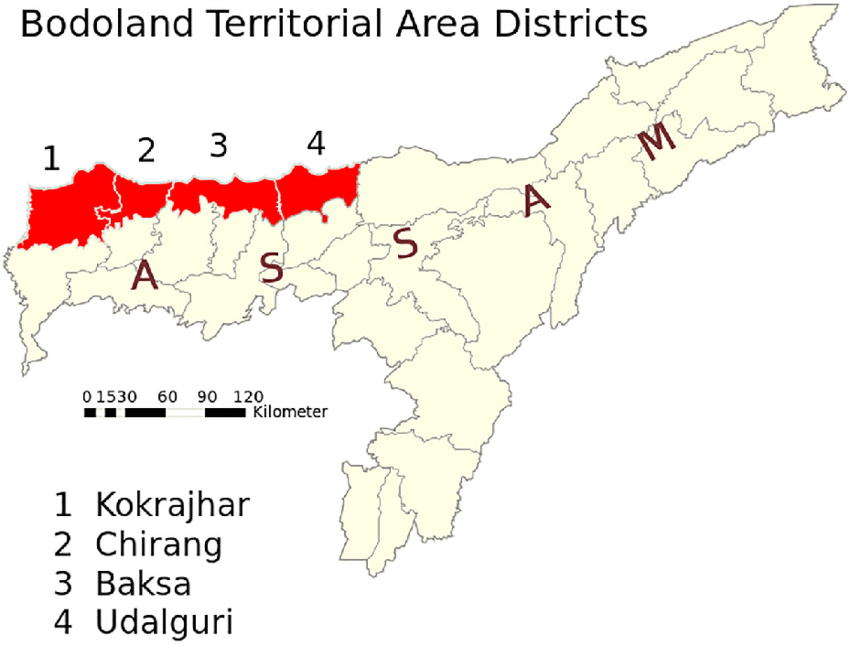Internal Security
Bodoland Territorial Region (BTR)
- 30 Aug 2021
- 5 min read
Why in News
The people displaced by ethnic and communal riots in areas under the Bodoland Territorial Region (BTR) since 1996 are set to return to the homes they left behind.
- The Ministry of Home Affairs (MHA), the Assam government and the Bodo groups signed a tripartite agreement to redraw, rename and change power-sharing agreement in the Bodoland Territorial Area District (BTAD) in Assam.
Key Points
- About:
- Population: Bodos are the single largest community among the notified Scheduled Tribes in Assam. They constitute about 5-6% of Assam’s population.
- Kokrajhar, Baksa, Udalguri and Chirang districts in Assam constitute the Bodo Territorial Area District (BTAD) and are home to several ethnic groups.
- Population: Bodos are the single largest community among the notified Scheduled Tribes in Assam. They constitute about 5-6% of Assam’s population.
- Dispute:
- Demand of Separate State: The first organised demand for a Bodo state came in 1967-68 under the banner of the political party called Plains Tribals Council of Assam.
- Assam Accord: In 1985, when the Assam Movement culminated in the Assam Accord, many Bodos saw it as essentially focusing on the interests of the Assamese-speaking community.
- As a result of this, several Bodo groups led by the All Bodo Students Union (ABSU) and National Democratic Front of Bodoland have been demanding separate land for the ethnic community, a movement that has claimed nearly 4,000 lives.
- Displacement of People: Between 1993 and 2014, more than 970 Bengali-speaking Muslims, Adivasis and Bodos died in clashes triggered by indiscriminate shooting by extremist groups, primarily the now-disbanded National Democratic Front of Bodoland (NDFB).
- Some of the 8.4 lakh people displaced by the violence have remained in shabby relief camps while others relocated to areas beyond present-day BTR. Over 2.5 lakh people were displaced in the Bodo-Santhal conflict.
- Bodo Accord:
- First Bodo Accord: After years of violent clashes, the first Bodo Accord was signed with the ABSU in 1993, leading to the creation of a Bodoland Autonomous Council with limited political powers.
- Second Bodo Accord: Under this, it was agreed to create a self-governing body for the Bodo Areas in the State of Assam.
- In pursuance of this, the Bodoland Territorial Council (BTC) was created in 2003 with some more financial and other powers.
- Third Bodo Accord: The agreement was signed in 2020, it renamed the BTAD as Bodoland Territorial Region (BTR).
- It promises more legislative, executive and administrative autonomy under the Sixth Schedule to Bodoland Territorial Council (BTC) and expansion of the BTC territory in lieu of statehood.
- It provides for alteration of the area of BTAD and provisions for Bodos outside BTAD.
- BTR includes the villages which are dominated by Bodos but are outside BTAD presently.
Bodoland Territorial Council (BTC)
- It is an autonomous region in the state of Assam in India.
- It is made up of four districts (Kokrajhar, Chirang, Baksa and Udalguri) on the north bank of the Brahmaputra river, by the foothills of Bhutan and Arunachal Pradesh.
- The area under the jurisdiction of BTC, formed under the 2003 Accord, was called the Bodo Territorial Autonomous District (BTAD).
- BTC is an area governed under the 6th schedule. However, BTC is an exception to the constitutional provision under the 6th schedule.
- As it can constitute up to 46 members out of which 40 are elected.
- Of these 40 seats, 35 are reserved for the Scheduled Tribes and non-tribal communities, five are unreserved and the rest six are nominated by the governor from underrepresented communities of the BTAD.
Autonomous Districts and Regional Councils
- Along with ADCs, the Sixth Schedule also provides for separate Regional Councils for each area constituted as an autonomous region.
- In all, there are 10 areas in the Northeast that are registered as autonomous districts – three in Assam, Meghalaya and Mizoram and one in Tripura.
- These regions are named as district council of (name of district) and regional council of (name of region).
- Each autonomous district and regional council consists of not more than 30 members, of which four are nominated by the governor and the rest via elections.
- All of them remain in power for a term of five years.





